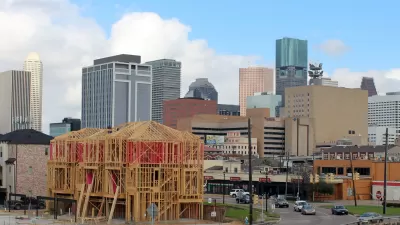A conversation with an architect yields insight into how Houston's pride in the lack of traditional land use regulation mechanisms has created the city as it exists today.

The Rice Design Alliance recently awarded its Spotlight Prize, recognizing up-and-coming architects, to the firm Oualalou + Choi, located in Paris and Casablanca. To commemorate the award, the Houston Chronicle excerpted an interview between Raj Mankad, of the Rice Design Alliance, interviewed Tarik Oualalou. The interview was originally published by the Houston-based architecture and design magazine Cite.
A few of the key excerpts from the interview, in which Mankad and Oualalou examine the city's land use regimes for insight into the city's built form. The interview, especially the portion excerpted in the Houston Chronicle, offers interesting opinions on the effects of planning and land use in this uniquely governed city, all from an architect's perspective:
- "You see spurts of building in short periods of time. So it's very dated. You see a lot of things in the late '70s, and then not in the '80s, a lot of things in the early '90s, and then not. These spurts of construction in short periods of time give it a very dated figure, almost like it's frozen in time….. It's not a city that builds over time. It just builds in moments. It creates a weird "stroboscopic" feel."
- "If there's no counter power, if there's no state, if there's no city, if there's no municipal system, if there's no public desire, organized public desire of sorts — whether it's community or elected or whatever it is — then the developer has no counter power."
FULL STORY: “Our responsibility as architects is to invent the form of public-ness:” An Interview of Tarik Oualalou

Pennsylvania Mall Conversion Bill Passes House
If passed, the bill would promote the adaptive reuse of defunct commercial buildings.

Planning for Accessibility: Proximity is More Important than Mobility
Accessibility-based planning minimizes the distance that people must travel to reach desired services and activities. Measured this way, increased density can provide more total benefits than increased speeds.

World's Largest Wildlife Overpass In the Works in Los Angeles County
Caltrans will soon close half of the 101 Freeway in order to continue construction of the Wallis Annenberg Wildlife Crossing near Agoura Hills in Los Angeles County.

Maine Approves Rent Relief Program
Legislators hope the assistance program will help struggling low-income households avoid eviction.

How Transit Architecture Impacts Real and Perceived Safety
More than a third of Americans believe major transit systems are too unsafe to ride. The built environment can change that.

New York Passes Housing Package Focused on New Development and Adaptive Reuse
The FY 2025 budget includes a new tax incentive, funding for affordable housing on state land, and support for adaptive reuse and ADUs.
City of Costa Mesa
Licking County
Barrett Planning Group LLC
HUD's Office of Policy Development and Research
Mpact Transit + Community
HUD's Office of Policy Development and Research
Tufts University, Department of Urban and Environmental Policy & Planning
City of Universal City TX
ULI Northwest Arkansas
Urban Design for Planners 1: Software Tools
This six-course series explores essential urban design concepts using open source software and equips planners with the tools they need to participate fully in the urban design process.
Planning for Universal Design
Learn the tools for implementing Universal Design in planning regulations.


























